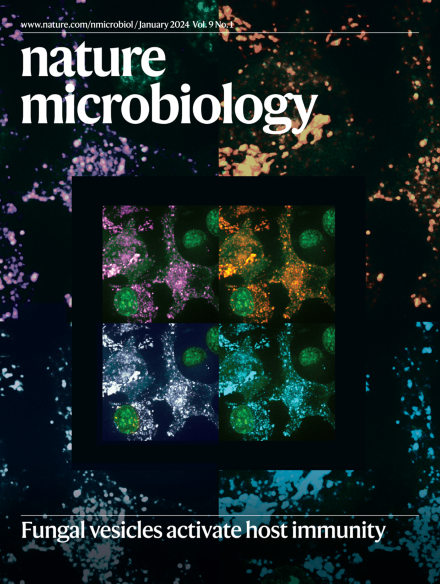水痘-带状疱疹病毒-宿主界面的多蛋白质组学分析揭示了宿主对严重感染的易感性
IF 19.4
1区 生物学
Q1 MICROBIOLOGY
引用次数: 0
摘要
水痘带状疱疹病毒(VZV)感染大多数人,引起水痘、带状疱疹和中枢神经系统病变。这些表型的分子基础仍然难以捉摸。在这里,我们对神经细胞系中64个VZV蛋白和感染诱导的扰动进行了多蛋白质组学调查,鉴定了900个相互作用蛋白和3,618个受调节的宿主蛋白。数据整合提示了病毒蛋白的分子功能,例如orf61通过募集E3连接酶辅助因子介导IFI16降解的机制。此外,我们确定了原宿主因子(MPP8和ZNF280D)作为限制感染的潜在靶点。整合vzv相关中枢神经系统病变患者的外显子组测序分析发现,肾囊素4是一种病毒限制因子,其S862N变体显示活性降低,与调节蛋白的结合减少14-3-3。总的来说,我们的研究提供了一个全面的疱疹病毒-宿主界面资源,这有助于我们理解疾病相关的分子扰动和数据驱动的抗病毒治疗选择的识别。本文章由计算机程序翻译,如有差异,请以英文原文为准。


Multi-proteomic profiling of the varicella-zoster virus–host interface reveals host susceptibilities to severe infection
Varicella-zoster virus (VZV) infects most humans and causes chickenpox, shingles and central nervous system pathologies. The molecular basis for these phenotypes remains elusive. Here we conducted a multi-proteomic survey on 64 individual VZV proteins and infection-induced perturbations in a neuronal cell line, identifying 900 interactors and 3,618 regulated host proteins. Data integration suggested molecular functions of viral proteins, such as a mechanism for the ORF61-mediated IFI16 degradation via the recruitment of E3 ligase co-factors. Moreover, we identified proviral host factors (MPP8 and ZNF280D) as potential targets to limit infection. Integration of exome sequencing analysis from patients with VZV-associated central nervous system pathologies identified nephrocystin 4 as a viral restriction factor, and its S862N variant, which showed reduced activity and decreased binding to the regulatory proteins 14-3-3. Collectively, our study provides a comprehensive herpesvirus–host interface resource, which aids our understanding of disease-associated molecular perturbations and data-driven identification of antiviral treatment options. Proteomic characterization of varicella-zoster virus–host protein interactions and infection-induced changes in a neuronal cell line identifies potential targets for drug discovery and molecular insights into severe disease.
求助全文
通过发布文献求助,成功后即可免费获取论文全文。
去求助
来源期刊

Nature Microbiology
Immunology and Microbiology-Microbiology
CiteScore
44.40
自引率
1.10%
发文量
226
期刊介绍:
Nature Microbiology aims to cover a comprehensive range of topics related to microorganisms. This includes:
Evolution: The journal is interested in exploring the evolutionary aspects of microorganisms. This may include research on their genetic diversity, adaptation, and speciation over time.
Physiology and cell biology: Nature Microbiology seeks to understand the functions and characteristics of microorganisms at the cellular and physiological levels. This may involve studying their metabolism, growth patterns, and cellular processes.
Interactions: The journal focuses on the interactions microorganisms have with each other, as well as their interactions with hosts or the environment. This encompasses investigations into microbial communities, symbiotic relationships, and microbial responses to different environments.
Societal significance: Nature Microbiology recognizes the societal impact of microorganisms and welcomes studies that explore their practical applications. This may include research on microbial diseases, biotechnology, or environmental remediation.
In summary, Nature Microbiology is interested in research related to the evolution, physiology and cell biology of microorganisms, their interactions, and their societal relevance.
 求助内容:
求助内容: 应助结果提醒方式:
应助结果提醒方式:


